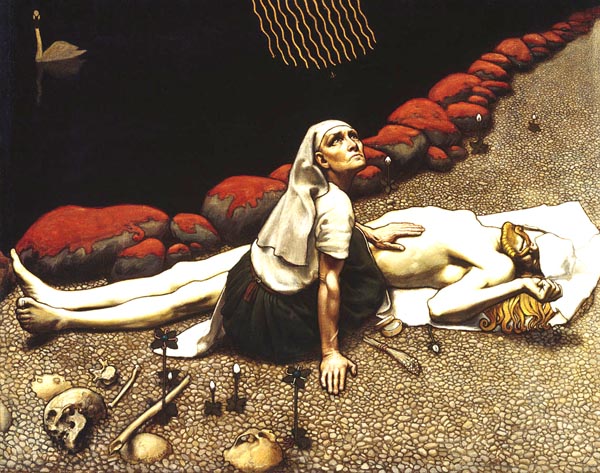 |
| Lemminkainen's mother reanimates him (Wikipedia) |
Note: A national epic can be a key part of a country's identity; though it was not compiled until the 19th century, the Kalevala plays just such a role for the people of Finland.
Get Ready: Does your country have a "national epic," or at least a body of work that captures the spirit of your people?
Until the 19th century, Finland had no national epic. First a part of Sweden, then Russia, the country gained independence in 1917; prior to that, in the 19th century, a national consciousness was developing, and the need was felt for a "common story."
That need was met by a doctor named Elias Lonnrot, who collected a smattering of folktales and assembled them into a cohesive story, the Finnish national epic called The Kalevala.
The story begins with a traditional Finnish creation myth, telling how the world was made from the egg of a sea-duck, and how the first man of the Kalevala people, Vainamoinen, was born to a goddess. As he seeks a wife, he forces Ilmarinen, the smith of the gods, to forge a magical object called the Sampo, which brings riches and good fortune to its owner.
Next, another hero, Lemminkainen, seeks a wife and, when he is killed and the pieces of his body scattered, his mother comes, gathers the pieces, and reanimates him. When at last he finds a potential wife, he loses her to Ilmarinen the smith, who must perform many arduous tasks to win her hand. Lemminkainen is not invited to the wedding.
Ilmarinen's wife torments a slave boy who tricks her into being torn apart by a pack of wolves and bears. Ilmarinen, grieving the loss of his wife, forges another out of gold and silver. But she is cold to him, so he abandons her. Instead, he kidnaps the daughter of a goddess, Louhi, but when the girl insults him, he turns her into a bird and, returning home to Kalevala, tells Vainamoinen about the wealth the Sampo is generating for Louhi.
These two, together with Lemminkainen, steal the Sampo from Louhi; in the battle to recover it, the Sampo is lost in the sea and destroyed. Louhi takes her revenge by sending disease to Kalevala and steals fire from them, as well as hiding the sun and moon. Vainamoinen and Ilmarinen heal the people, restore the fire, and force Louhi to return the sun and the moon.
In the end, a virgin becomes pregnant by eating a berry; her son becomes king of the land, and Vainamoinen sails away to return when there's no moon or sun and happiness isn't free anymore.
--------- Read more: https://en.wikipedia.org/wiki/Kalevala
- Read Kalevala rendered into English verse FREE online
- Read a long summary in prose here, with selected passages in poetry
Practice: Match the term to its definition below:
- a smattering
- arduous
- cohesive
- consciousness
- folktales
- forge
- reanimates
- scattered
- smith
- virgin
- brings back to life
- difficult; burdensome
- awareness
- make from metal
- a person who makes things from metal
- holding together in one piece
- stories told by the common people
- bits and pieces
- a person who has never had sex
- spread around
Answers are in the first comment below.
Submitted to the Shenzhen Daily for April 13, 2022


Answers to the Practice: 1. h; 2. b; 3. f; 4. c; 5. g; 6. d; 7. a; 8. j; 9. e; 10. i
ReplyDelete